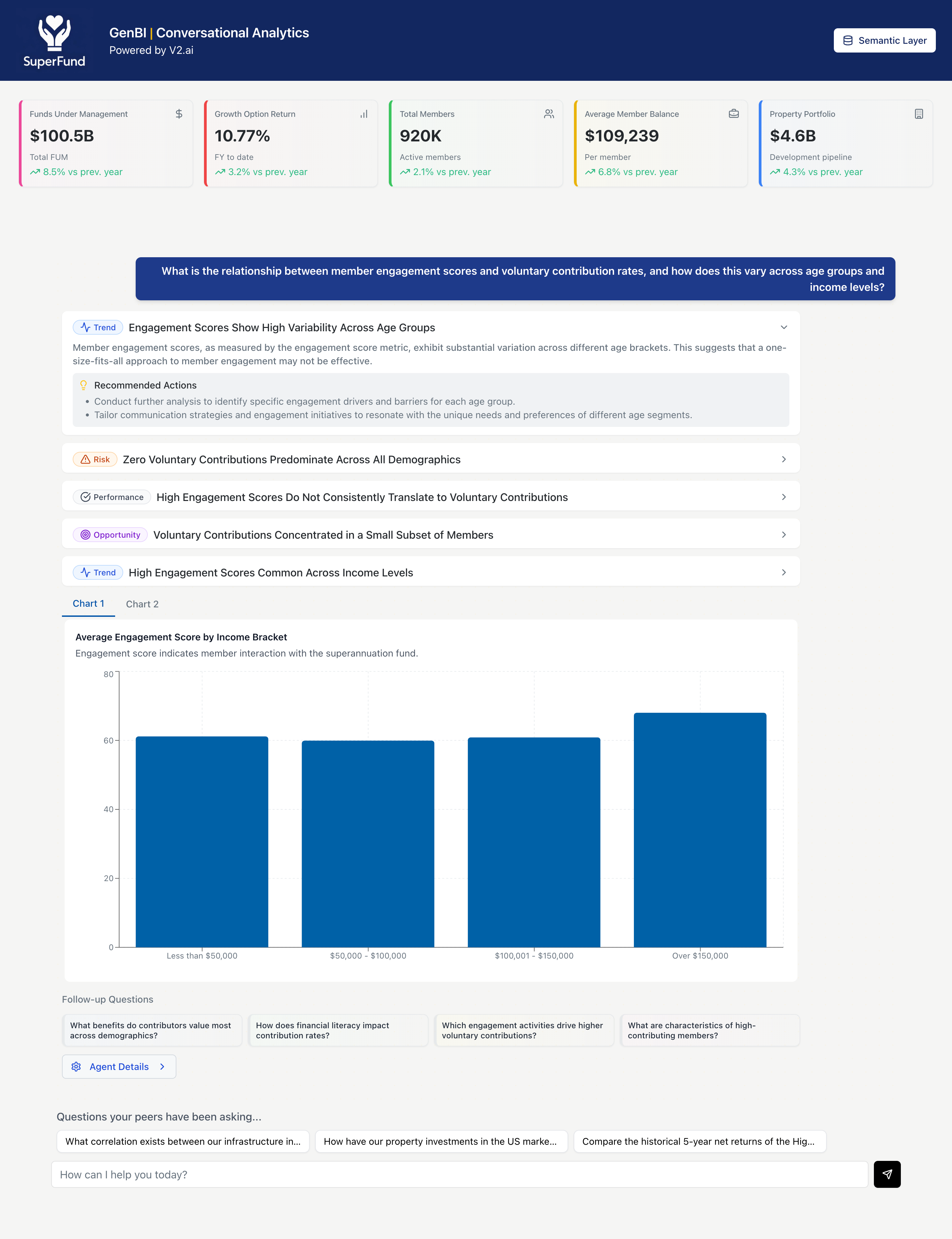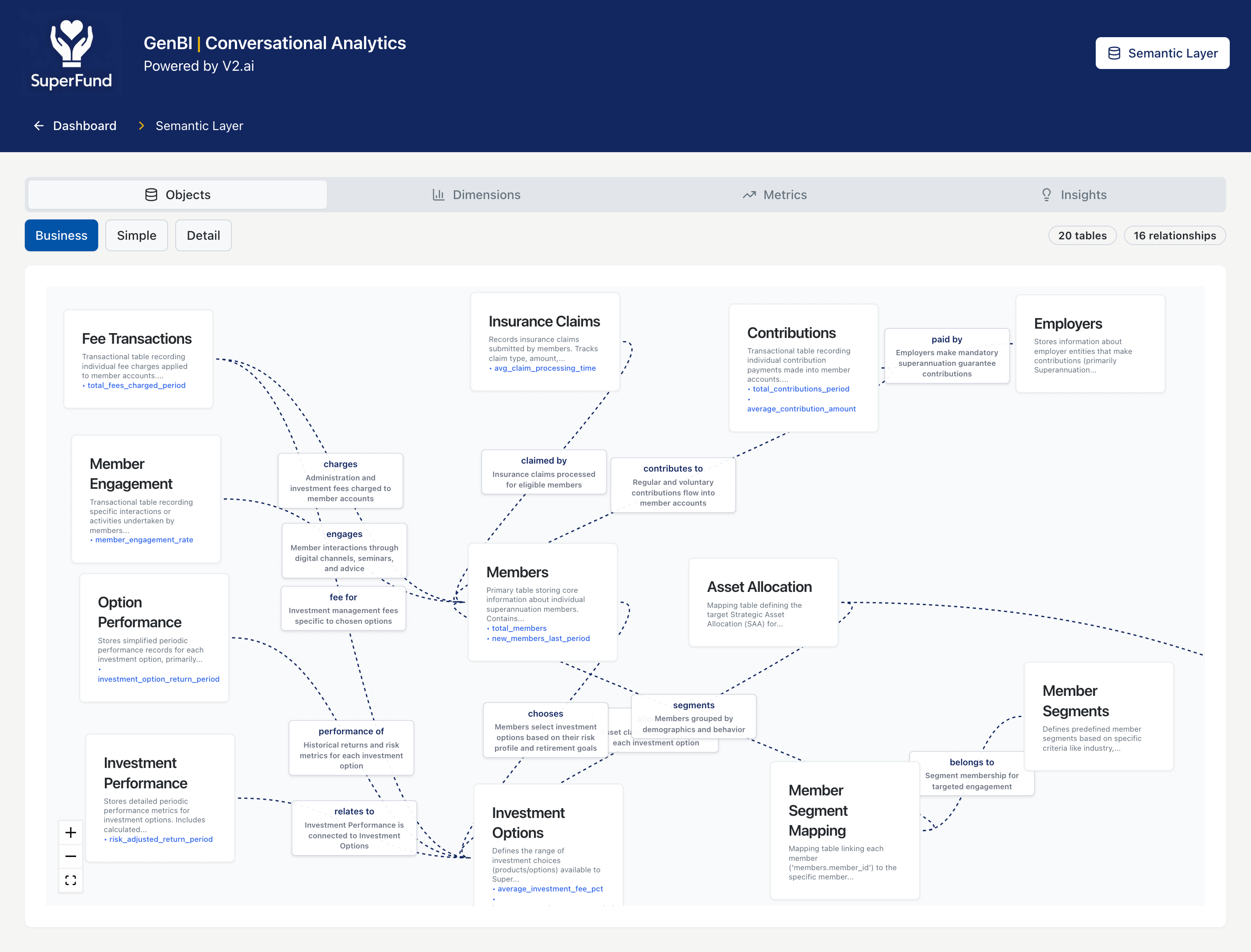Organisations today face an ongoing analytics challenge. Business demand for data insights far outstrips the capacity of data and analytics teams to deliver. Weeks-long waits for dashboards and reports have become the norm, creating frustration and slowing business momentum. This gap isn't sustainable in a competitive landscape where decision speed directly impacts business outcomes.
Conversational analytics, also called generative business intelligence (GenBI), offers a compelling solution that starts to bridge the gap. It allows users to chat with enterprise data and discover insights through natural language interactions. GenBI puts analytics capabilities directly into business users' hands, taking away the need for technical expertise.
But getting GenBI right requires more than bolting a chat interface onto existing tools.
This guide explores the business impact of GenBI and how you can get started with rolling this out in your enterprise.

What conversational analytics can look like
Three Critical Challenges Solved by GenBI
Conversational BI directly addresses three major enterprise challenges:
Breaking Data Team Bottlenecks
The traditional data request process is maddeningly slow. Business users submit requests to data teams who build queries, generate reports, and iterate through feedback cycles. This process takes weeks, creating frustration and slowing business momentum.
GenBI fundamentally changes this dynamic. It enables direct data conversations, eliminating the intermediary role data teams have been forced to play for decades. Your data professionals can redirect their efforts to higher-value activities like data architecture and complex analyses, while business users get immediate access to the insights they need.
Removing Technical Knowledge Barriers
Traditional BI tools require understanding SQL, data modelling concepts or specialised interfaces. This technical barrier limits access to a small user subset, creating information gatekeepers throughout your organisation.
Conversational analytics opens data access to everyone. A marketing manager can simply ask, "What was our customer acquisition cost last quarter by channel?" instead of learning SQL joins or mastering visualisation tools. The GenBI system translates intent into proper queries, retrieves data, and delivers insights in accessible formats.
Accelerating Decision Velocity
In today's business environment, decision speed directly impacts competitiveness. When insights are delayed by weeks, opportunities vanish and threats grow.
By providing immediate access to insights, conversational BI dramatically accelerates decision velocity. Through interactive dialogue, your business leaders can test hypotheses, explore data patterns, and make evidence-based decisions in real time. This capability transforms data from a historical record into a dynamic decision-making tool.
Semantic Layers: The Foundation That Makes or Breaks GenBI
Your organisation needs an intelligent semantic layer foundation to get started with conversational analytics.
Think of the semantic layer as your organisation's data translation centre. It sits between technical data sources (databases, warehouses) and the business users who need insights. This layer takes complex technical structures and converts them into well-defined business concepts, for example:
Metrics like revenue and customer count
Dimensions like product and time
Hierarchies like sales regions, and
Data calculations.
Semantic layers aren't new; they've existed as long as BI tools have. The critical shift now is moving this layer out of specific tools where it's been hidden away. Modern semantic layers function as standalone components in your data infrastructure, providing open access for defining and using data meaning across all organisational levels.
This evolution matters because a semantic layer delivers actual data comprehension. It establishes precise connections between business concepts and physical data, determining and maintaining uniform interpretation methods. Your revenue and other business term definitions stay consistent everywhere in dashboards, data products and AI chatbots. This consistency is essential for breaking down silos and building trust in data insights.
Without a semantic layer, GenBI systems can't reliably interpret business questions or generate trustworthy answers. To summarise, the intelligent semantic layer provides:
Consistent business definitions: Ensuring terms like "revenue" have a uniform meaning
Relationship mapping: Creating clear connections between business concepts and data
Calculation logic: Defining how metrics get aggregated and analysed
Clear governance: Enabling administrators to establish access controls throughout

The semantic layer visualised
How Multi-Agent Systems Transform Business Questions into Insights
At V2, we are currently working with several clients in the education, energy, and finance sectors to help them achieve the promise of GenBI. Our team has developed an accelerator that combines the intelligent semantic layer with autonomous AI systems, called AI agents, that work together to make conversational analytics possible. Each agent has a specific role in the journey from question to insight:
Intent Agent
The intent agent analyses your question to identify metrics, dimensions and visualisation needs. When someone asks "What was our customer acquisition cost last quarter by channel?", this agent recognises they need the "acquisition cost" metric, broken down by "channel", for "last quarter".
SQL Agent
The SQL agent generates optimised database queries, handling complex joins and aggregations that typically require a data analyst. It pulls precisely the data needed to answer the question.
Visualisation Agent
The visualisation agent creates appropriate visuals based on the data and question context. It knows that trend data works best in line charts, comparisons in bar charts, and relationships in scatter plots.
Insights Agent
The insights agent finds meaningful patterns beyond raw numbers. It might highlight that "Social media channels improved 12% compared to the previous quarter" or "Email delivers the lowest acquisition cost across channels."
Context Agent
The context agent maintains conversation history for natural follow-ups. When someone asks, "Which channel improved the most?", this agent knows they're still referring to acquisition costs from the previous question.
This intelligent collaboration happens in seconds, delivering insights that your data team previously took days or weeks to produce.
Designing for Different Personas: One Size Doesn't Fit All
The separation between the underlying technology and the end user experience is crucial when rolling out GenBI. Your semantic layer provides consistent definitions across the organisation, but how users interact with those definitions should be tailored to their specific roles and data literacy levels.
A critical mistake many organisations make is treating all data users the same. The reality? Different business units have vastly different data needs, technical abilities and ways of interacting with insights.
Financial analysts might be comfortable with complex data models and want to drill deep into forecasting trends, requiring sophisticated analytical capabilities. Meanwhile, customer service managers need intuitive dashboards that instantly reveal customer sentiment patterns without requiring technical expertise.
As users mature in their data journey, their needs evolve too. A customer service manager who initially just wants simple sentiment analysis might gradually develop more sophisticated requirements, wanting to correlate sentiment with other metrics or examine trends over more extended periods. Your solution must accommodate this growth, providing progressive disclosure of capabilities as users become more adept.
In practice, this means designing your GenBI implementation with specific personas in mind:
What questions do they typically ask?
What metrics matter most to their role?
How do they prefer to visualise information?
What decisions are they trying to make with data?
When designing our V2 GenBI solutions, we always start by mapping these personas and their journeys before implementing any technology. The goal isn't to simplify the technology (though that might be part of it), but to deliver meaningful, job-relevant insights in forms that specific users can easily consume and act upon.
Building Trust in Your GenBI Solution
Long-term success depends on users developing trust in the system. This requires:
Strong governance through clear rules, security measures and data quality standards
Transparent operations so users understand where insights come from and how they're calculated
User-centred design that adapts to different personas, data literacy levels and analytical needs
Continuous feedback loops to refine and improve the system as needs evolve
Moving Forward
The future of business intelligence is conversational. Organisations implementing GenBI effectively will gain significant advantages through faster, more informed decision-making at every level.
Success requires more than just deploying the latest tech. You need robust semantic foundations, an intelligent multi-agent framework, and user-centred design principles. Get these elements right, and you'll transform how your organisation leverages data. You can democratise access by eliminating bottlenecks and dramatically accelerating business decisions.
The question isn't whether conversational BI transforms analytics, it's whether your organisation is ready to make the shift.
Contact V2 to learn more about how we can help you roll this out across your organisation.




